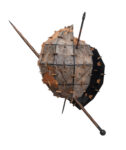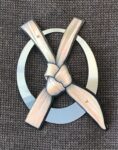Graham Bennett
For background on the artist and works, see below.
Current Works

On the Brink
Sold
Fragment 2

Fracture 2 – Precipice #1-#5

Fracture 2 – Precipice (detail of #1, #6)

Fracture – Kaju Studio Yataka Yama, Japan

Fracture – Yakage Honjin, Japan

Disrupt Trio
Sold
Disrupt #5, Bk3, 34, 3, 1

Precipice

Disrupt Bk3; #31; #1

Fracture Study #5

Fracture Study #10

Fracture Study #11

Disrupt Sculpture Study #4
Sold
Disrupt Sculpture Study #2

Ukabu
Sold
Study from Fracture

Playing for Time
Sold
Around Every Circle

Study for Pooling Ignorance

Remarkable 2
Sold
Study for Sculpture Karihi – 2

Remarkable 3

Hidden Depths

Latitude 41º 12.2’S Longitude 173º 19.7’E
Sold
Hard to Swallow

Mimic

Connect

Connect

Study for Sculpture – Gauge
About the Artist
Graham Bennett is probably best known in New Zealand for two very high profile sculptures – Reasons for Voyaging, the soaring seven-pillar installation outside the Christchurch Art Gallery in Montreal St, and the Tribute to Firefighters he was asked to create in Christchurch from steel girders sent to him from the World Trade Center ruins in New York. However his practice is much wider, and in recent times focused particularly on issues of sustainability and our relationship with the planet.
He featured as the cover story of the 2014 Winter edition of World Sculpture News, in an article focused particularly on the 10-year Survey Exhibition of his work, at The Suter Public Art Gallery in Nelson, NZ. This followed on from a residency in Seoul, South Korea, in which he created a towering outdoor sculpture Tipping Point now on permanent display. He also works in miniature, such as the meticulously worked Wait Watcher series, and in jewellery based on his sculptures, effectively sculpture for the body.
Bennett’s sculpture is an evolution of ideas and philosophies based on concepts of sustainability, and of voyaging, past present and future, connection between islands in the Pacific, connections between the primordial land and man’s temporary imposition on it, with our structures imposed on or cutting into the land, and particularly of connections and differences between cultures across the world.
He considers questions of identity, and our sense of place. His work often features lines of latitude and longitude, the phases of the moon and passages of planets across the Earth, as followed by explorers through the Pacific, such as the Transit of Venus.
He uses impermanent man-made materials – like steel – against natural materials like rock and wood, to express those ideas. He was born in Nelson, the geographic centre of New Zealand, near the natural rock formation the Boulder Bank, and this has influenced his work. Faultlines and geothermal lines project out from New Zealand to places across the Pacific, with the concept that the waters that lap our shores, also break on their coast, and thus connect us.
Recent Works
The major series WADE confronts us with the dire state of so many of our waterways, and the need for us to urgently address issues of pollution and the consequences of our poor land management, over irrigation and unsustainable practices. Bennett moves from using abstracted forms to digitally printed images of young women, referencing the central figures in Hieronymus Bosch’s Garden of Earthly Delights (circa 1500 AD), innocent women standing in a pond. He challenges us to not look away, but to engage and think about the significance of that painting, and questions of what inheritance we will pass to the next generation – and what needs to change. The WADE exhibition first exhibited in Christchurch and will tour to other locations in future. Works other than the maquette are sold on condition of later availability for public exhibition.
A recurring motif is based on the ‘orange peel segment’ flattened map of the world. Each segment is also the shape of a canoe or vessel; when standing vertically his pieces sometimes further suggest a human element or vertebrae. Recent works bring together four of those segments to form a closed pod shape, reaching upwards and out.
Graham Bennett completes detailed studies on paper for each of his sculptures, but these are not so much plans for sculpture as paintings conveying the feeling as much as the dimension and scale of the intended works.
Lately his work focuses on questions of balance in our impact on the environment, and the idea we are moving dangerously close to the ‘tipping point’ of no return or remediation. A major commission in Seoul, South Korea, featured a human figure he calls the invisible man, arms outstretched, turning atop a five-metre pole structure. The figure casts a shadow below, suggestive of our impact on the environment. Watching the shadow move across the grid of paving stones, he developed ideas for a new series ‘Heavy Shadows’, laser cut in corten steel, the figure seemingly caught in a net of his own making or perhaps pulled in different directions. A small series of beautiful Echo wall works, focus as much or more on the figure’s shadow than the solid work itself.
After a major survey show of the last 10 years of Bennett’s work at the Suter Gallery, in Nelson, the artist has released several of the works in that exhibition for sale, from his personal collection.
Hard to Swallow – a plea for the whales
In 2012, in conjunction with The National Whale Centre, The Diversion and Graham Bennett staged an exhibition entitled ‘Hard to Swallow’ with 267 small sculptures laser cut from tin plated steel, each one representing a whale killed in the Southern Ocean ‘harvest’ of 2011-2012. The intended kill of 990 was cut short by the Sea Shepherd protests and by storms. With heavy irony, Bennett used text and motifs from a real whale meat tin within the composition, including the base text saying ‘Be Careful not to cut your hand on the tin when opening’. The laser cut sculptures cast a shadow on the wall, our impact on the whales’ environment.
Each work is individually numbered and signed, and priced at just $267 + GST (the number of the whales killed); making them accessibly priced to encourage a kind of viral marketing of the idea, with each new owner telling the story to those who view their work.
More About the Artist
Born in Nelson, Graham Bennett graduated from the Canterbury School of Fine Arts in 1970. He has received numerous major NZ Arts awards including the Fellowship in Visual Arts from the NZ Arts Council in 1995 and the Asia 200 Foundation Grant the same year and in 1999. He was Principal Lecturer in the School of Art and Design at Christchurch Polytechnic for several years but has for some years been a full time artist with increasing demand for his work nationally and internationally.
His work is included in several major outdoor private and public sculpture parks, including Gibbs Farm, Brick Bay, Connell’s Bay, and Sculpture on the Gulf. He has participated in major sculpture events here and overseas. He has exhibited a dozen times in Japan, including two international exhibitions, and has a work in the New Zealand embassy in Tokyo. Some of the works we have available were exhibited in Hong Kong in 2009.
He has three times featured as the cover story in World Sculpture News, and his story is one of being a New Zealander and of identity in the context of a vast world, and finding a balance between our use of resources and sustainability of the environment.
In late 2020, a stunning book on his work was published by Ron Sang Publications – the latest of its prestigious series on leading New Zealand artists. This 300 page, beautifully produced volume is currently available in selected bookstores and galleries including The Diversion Gallery and gives a richness of context and thinking to consideration of Bennett’s work.
Please contact us to confirm current prices: most prices are posted at the time of exhibition, and may be revised as the artists' values increase.
